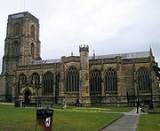
Church of St John the Baptist, Yeovil
Encyclopedia
The Church of St John the Baptist in Yeovil
, Somerset
, England was built in the late 14th century and has been designated as a Grade I listed building.
The tower, which was built around 1480, is 92 feet (28 m) high, in 4-stages with set back offset corner buttresses. It is thought that the work was supervised by William Wynford
, master mason of Wells
. To meet the growing size of Yeovil and the increased population, work on Holy Trinity Church began on 24 June 1843 to relieve the pressures on St John the Baptist church. In 1863, pressures on space in the graveyard were alleviated by the opening of Preston Road cemetery.
The church is capped by openwork balustrading matching the parapet
s which are from the 19th century, when major reconstruction work was undertaken from 1851-1860. There are two-light late 14th century windows on all sides at bell-ringing and bell-chamber levels, the latter having fine pierced stonework grilles. There is a stair turret to the north-west corner, with a Weather vane
termination. The tower contains two bells dating from 1728 and made by Thomas Bilbie of the Bilbie family
in Chew Stoke
. The "Great Bell" was recast from 4502 lb (2,042.1 kg; 321.6 st) to 4992 lb (2,264.3 kg; 356.6 st).
Yeovil
Yeovil is a town and civil parish in south Somerset, England. The parish had a population of 27,949 at the 2001 census, although the wider urban area had a population of 42,140...
, Somerset
Somerset
The ceremonial and non-metropolitan county of Somerset in South West England borders Bristol and Gloucestershire to the north, Wiltshire to the east, Dorset to the south-east, and Devon to the south-west. It is partly bounded to the north and west by the Bristol Channel and the estuary of the...
, England was built in the late 14th century and has been designated as a Grade I listed building.
The tower, which was built around 1480, is 92 feet (28 m) high, in 4-stages with set back offset corner buttresses. It is thought that the work was supervised by William Wynford
William Wynford
William Wynford was one of the most successful English master masons of the 14th century, using the new Perpendicular Gothic style. He is first mentioned in 1360 when at work at Windsor Castle as warden of masons' work...
, master mason of Wells
Wells
Wells is a cathedral city and civil parish in the Mendip district of Somerset, England, on the southern edge of the Mendip Hills. Although the population recorded in the 2001 census is 10,406, it has had city status since 1205...
. To meet the growing size of Yeovil and the increased population, work on Holy Trinity Church began on 24 June 1843 to relieve the pressures on St John the Baptist church. In 1863, pressures on space in the graveyard were alleviated by the opening of Preston Road cemetery.
The church is capped by openwork balustrading matching the parapet
Parapet
A parapet is a wall-like barrier at the edge of a roof, terrace, balcony or other structure. Where extending above a roof, it may simply be the portion of an exterior wall that continues above the line of the roof surface, or may be a continuation of a vertical feature beneath the roof such as a...
s which are from the 19th century, when major reconstruction work was undertaken from 1851-1860. There are two-light late 14th century windows on all sides at bell-ringing and bell-chamber levels, the latter having fine pierced stonework grilles. There is a stair turret to the north-west corner, with a Weather vane
Weather vane
A weather vane is an instrument for showing the direction of the wind. They are typically used as an architectural ornament to the highest point of a building....
termination. The tower contains two bells dating from 1728 and made by Thomas Bilbie of the Bilbie family
Bilbie family
The Bilbie family were bell founders and clockmakers based initially in Chew Stoke, Somerset and later at Cullompton, Devon in south-west England from the late 17th century to the early 19th century....
in Chew Stoke
Chew Stoke
Chew Stoke is a small village and civil parish in the Chew Valley, in Somerset, England, about south of Bristol. It is at the northern edge of the Mendip Hills, a region designated by the United Kingdom as an Area of Outstanding Natural Beauty, and is within the Bristol/Bath green belt...
. The "Great Bell" was recast from 4502 lb (2,042.1 kg; 321.6 st) to 4992 lb (2,264.3 kg; 356.6 st).

